Abstract
In most rope transport devices, the used steel wire ropes are replaced with new ones after working for a certain period of time, or after reaching the acceptable level of wear. The operational safety of the entire system depends on the correct diagnosis of the condition of the working wire rope. This is not easy, because the working lives of the ropes are varied, and their wear depends on many factors, including random ones. This article presents three different aspects of the work of steel ropes in mining-shaft hoists. What they have in common is a stochastic approach to interpreting the level of rope wear. The process of progressive wear due to fatigue breaking of wires is presented as the first example. This process is non-linear with a strong upward trend, which, in the final stage, turns into a phase often referred to as “explosive”. The rate at which subsequent wire breaks appear is influenced by numerous random factors, e.g., in the form of different methods and materials from which a given rope is constructed. However, the character of the progressing wear process is most affected by the random distribution of stresses experienced by individual wires and the randomly variable nature of the working environment. The second aspect presented in this article is an attempt to determine the probability of wire breaks of the rope. This was presented on the example of wear of the hoisting rope of a mining-shaft hoist. The last aspect of a stochastic nature, which is discussed in the article, is the issue of separating individual components of this distribution from the multimodal distribution describing the tensile strength of the rope wires, possibly of a normal character. Modern methods of analysis allow such distributions to be assigned to specific structural elements of the wire rope. This gives information about which structural elements of the rope wear faster or unusually and, consequently, determine its strength. This was presented on the basis of the results of strength tests of the wires of the mining-shaft hoist rope, which broke due to excessive corrosion wear of the inner strands. The presented examples explain only a short part of randomness in the description of working ropes, but the intention of the authors is to draw the attention of the personnel responsible for their safe operation to unavoidable random factors.
1. Introduction
The term sustainable development is interpreted in various ways, but there are always three most essential aspects of it in every field. The first is to minimize the burden on the environment by acquiring raw materials, waste-free production, and water and air protection, etc. The second aspect is to profit from the activity with a minimum of resources, preferably, with the involvement of new technologies. The third area covers the social context and purpose of these activities in such a way as to raise the standard of living and social awareness generally.
The authors of this article deal with the exploitation of steel ropes in various fields of technology. They aspire to develop such procedures for using steel ropes that meet all safety criteria, but, at the same time, that their service life from the economic point of view is as long as possible. These seemingly mutually exclusive tasks are possible to be fulfilled at the same time. A necessary condition is that the sustainment of ropes is based on a multi-criteria testing system. This condition is met in almost all areas where ropes are operated: ropeways, off-shore facilities, and all types of cranes. This system is based on European law in Europe and interpreted by the relevant directives. However, this does not apply to the mining industry, which is subject only to national regulations. This industry uses large amounts of expensive and difficult-to-dispose-of ropes. Any extension of rope operation time in this area can be interpreted as sustainable development.
Nevertheless, the work of ropes results not only from the laws of mechanics and, generally, from the laws of nature. Ropes wear very differently and, sometimes, in surprisingly unexpected ways. Therefore, this article is devoted to stochastic issues occurring in the operation of steel ropes. Three such areas were identified and described. The aim is to cause the personnel examining and deciding about the working time of ropes to be aware of how random phenomena affect the safety and working time of steel ropes. The practical application of the conclusions drawn from these considerations should, generally, extend their operating time without compromising operational safety.
Deep mining-shaft hoists are systems for transporting people and conveying coal or ore and other materials. Their safety basically depends on a correct assessment of the condition of the hoisting wire ropes working there. These ropes are subject to several wear processes. They wear as a result of wire fatigue, corrosion, loss from abrasion [1], deformation caused by changes in their geometry [2], and rope core and lubrication damage [3]. Fatigue manifests in wire breakage, and the standard method of representing this process is to plot the number of wire breaks as a function of rope running time or number of running cycles. The wires break because they have a limited fatigue life. This paper presents examples of a number of such characteristics. Their course depends on many parameters, the most important of which is the varying load and the distribution of the resulting stresses on the individual wires in strands of the rope. This is influenced by random factors that are, practically, difficult to predict. The process of rope wear as a function of the number of fatigue cycles accruing is a process inherent in every rope. This process varies over time to, finally, enter the so-called ‘explosive’ phase. Observation of the number and rate of accumulation of wire breaks makes it possible to withdraw a working rope from operation before this dangerous phase, or even predict when it will occur. The theoretical basis for the working time of wire ropes was developed in [4].
The quality of the ropes and durability in the operational process depend on the set of features and properties of the rope elements (wires, core, lubricant, etc.). To determine the quality of ropes and wires, measurable features are assumed, which result from the rope construction, manufacturing technology, mechanical strength, and physical properties of the wires used in the production of ropes. The quality of wires and ropes relates to all these characteristics which cannot be considered separately. For ropes and wires, the following factors are of crucial importance for the quality of ropes:
- −
- geometrical properties: related to the construction, rope diameter, rope pitch length, i.e., deviations of wire and rope diameters, cross-sectional shape, pitch length of wires in a strand and strands in a rope, unit weight of a rope, the direction of winding of wires in a strand, and the strands in a rope;
- −
- chemical properties and structure of the material: chemical composition of steel wires. The surface condition of the surface layer of wires, surface roughness, metal structure, type of protective coating against corrosion, lubricating properties, material and properties of the rope core, etc.;
- −
- mechanical and strength properties, such as the actual breaking force of the rope, the strength efficiency of the rope, fatigue life, modulus of elasticity, the transverse stiffness of the rope, the moment of unscrewing the rope, the tensile strength of wires, resistance to bending and twisting of wires (fatigue life), and stress state in knitting.
The indicated parameters affect the nature of the damage and the possibility of their occurrence during operation.
From an operational and research point of view, determining the probability of wire breakage of a working rope is very important task. The second part of this article focuses on this issue. In the literature on the safety of wire ropes operated in mine-shaft hoists, the basic model for rope failure/breakage is in the form of two overlapping random distributions. One distribution relates to the random load on the rope under given operating conditions. This takes into account fixed loads, dynamic loads, and resistance forces to movement. The other distribution describes the decrease in strength of the rope due to wear, in all its forms. The overlapping area is interpreted as the probability of rope failure/breakage. In all sources known to the authors of this article, these graphs are exclusively illustrative of the stochastic aspect of rope failure/breakage, due to the simple reason that sections of ropes in use cannot be broken. The authors of this paper have not found any examples where the probability at which rope damage or breakage will occur is at least estimated. This paper presents a different approach. It is an example using results determined from strength tests for a rope after its withdrawal from service.
The third part of this paper presents the problem of analyzing the stochastic distributions of wire strength from different sections of rope and from its various components, such as core wires, and inner and outer strands. These components undergo different wear processes. An interesting problem is to find the source of the weakening of a given rope section. Such distributions are multi-modal in nature. Methods used here include those used in demographic sciences [5,6] or in other studies [7,8,9]. A relevant example is presented. The whole article ends with conclusions and a list of cited literature. The main objectives of the work are listed below. Figure 1 presents the methods of conduct for graphical stochastic analysis of the wear processes of steel wire ropes.

Figure 1.
Graphical presentation of the methodology of the conducted research and analysis.
2. Non-Linear Cumulative Wire Rope Wear Process
Analyzing the suitability of wires for the production of steel rope is one of the criteria for assessing the quality of ropes and their durability in the operation process. Fatigue life affects the working time of the rope. Fatigue is one of the leading causes of rope wear. To determine the fatigue strength of wires, fatigue tests with different frequencies are used. Fatigue testing methods are costly and laborious. Much energy is used to perform tests, and machines are needed for which similar accurate parameters can be used, such as the number of inflexions.
Despite the precise selection of parameters at the stage of their implementation, they behave very differently under different load and environmental conditions. To determine the durability of ropes, fatigue life tests are performed on particular machines, as presented below. However, ropes work very differently under such controlled and repeatable conditions. This is determined by several random factors that determine the working time of the ropes already at the production stage. Examples of such studies are provided below. Figure 2 shows four wear patterns of wire ropes of triangular-strand structures as a function of the number of fatigue wire cracks observed as a function of the number of cycles worked on a fatigue machine with two bending wheels. The actual tests and their evaluations were presented in the literature [10]. The method of performing such measurements is presented in [11]. The length of bending distance was approximately 6.5 m and wire cracks were identified using the acoustic method. Figure 3 shows five test results of the same ropes, but with different loads. The runs highlighted in red palette colours refer to the average 20% longitudinal force load on the ropes related to the breaking force of the ropes as a whole. The runs shown in green refer to a load of 15%. The presented runs allow three general conclusions to be drawn. The working time of ropes is affected by their proper manufacturing and quality [12]. During operation, various forms of wear have an impact on the rope: abrasive wear, fatigue, as well as deformations related to the changing twist torque [13]. Abrasive wear also occurs inside the rope as a result of the movement of strands and wires while high-point pressures occur. The service lives of less-loaded ropes is longer and their wear patterns are smoother. All the runs shown in red and green illustrate the same conditions for the use of ropes of the same design and manufacture. Nevertheless, significant differences can be observed in the performances of the individual ropes under the same conditions described with the same average loads. The main differences shown in the second figure can be explained by random variations in the individual wires of the particular ropes. The presented graphs clearly show that the working time of the ropes up to a certain level of wear is determined both by the average load (easy to determine) and the random distribution of the load on the individual wires. This variable is difficult to take into account because it is random by nature. The graphs shown have a common feature. For more information, see monograph [14].
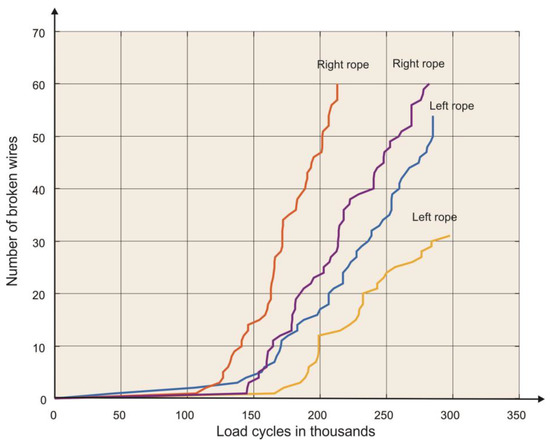
Figure 2.
Examples of fatigue wear of steel 44 mm wire ropes of triangular-strand construction with right and left lay directions.
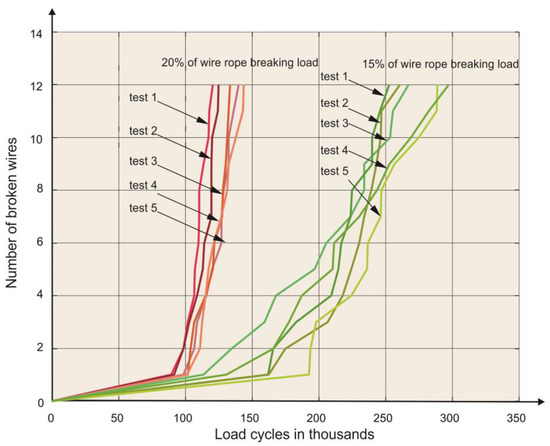
Figure 3.
Examples of fatigue wear of steel wire ropes 44 mm of a triangular-strand construction with different loads.
The working time of ropes defined by the wear curve has three distinct phases: an initial phase characterized by the absence of or mild increase in wear, a final phase in which wear is rapid (‘explosive’), and a short transition phase between the two. The fatigue wear processes shown are very typical of three-strand ropes as they wear mainly due to fatigue of the wire material. Their courses can be approximated by power equations as shown in Equation (1). The fatigue process follows a logarithmic curve [15,16].
where: z—number of fatigue scraps; a, b—coefficients of the equation; and N—number of fatigue cycles.
The numerical forms of the equations fitted to the runs shown in Figure 1 are not presented in this article. The equations for the examples shown above were estimated with a linear determination coefficient above 0.95. This shows that the power model describes such wear processes very well, and only less than 5% of the variation is not described by it. Therefore, it is suitable for the prediction of the wear of wire ropes from wear of this type. The problem becomes more complicated if the ropes suffer both corrosive and abrasive wear simultaneously. The abrasion is visible as an ellipse formed on the wire surface, which affects the strength properties of the wire [17]. This issue is not discussed in this article.
3. Probability of Occurrence of Wire Cracks in the Working Rope of a Mine-Shaft Hoist Installation
In the process of operation, steel ropes are put down due to the level (wear level) determined by visual tests (VT) or based on magnetic rope tests (MRT). When putting them away, they sometimes seem to be in good condition. Below is an example of calculating the probability of a rope failure when it is in use. For example, with the postponement criteria currently used in Poland, this probability is high in the final phase. This should entail increasing the number of checks and tests on ropes. It should also be noted that both methods are entirely noninvasive and cheap, and they are constantly developing, which increases the accuracy of such tests. Few authors have dealt with the stochastic processes of steel ropes so far. The literature is in Polish [18].
The literature on the operational reliability of technical equipment provides a definition of failure as a random event. It is the probability of such an event that the value of the load (stress) is higher than the strength, i.e., the ability to carry this load [19]. Both factors, load and strength, are stochastic in nature. This definition is illustrated as shown in Figure 4, with random distributions of load and strength. In the known literature, the Wöhler curve and the strength function have been defined for applications in steel alloys. An integrated continuum mechanics model with a genetic algorithm was investigated for the multi-axis fatigue response of steel samples [20,21,22,23,24,25,26].
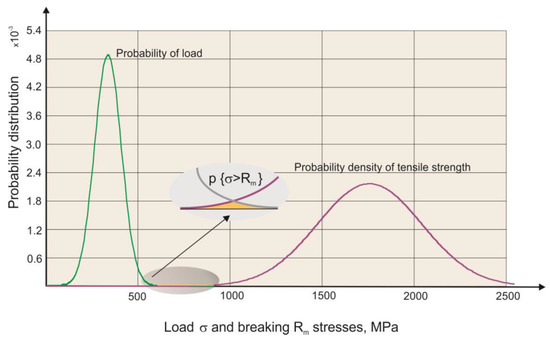
Figure 4.
Graphical interpretation of the damage to the steel wire rope as a random event.
The probability of a failure event is represented by the area where these two distributions overlap. Reliability models for objects are described in the literature, and their analysis and durability prediction are widely spread [27,28,29,30,31,32].
This concept has been used in this work to calculate the probability with which the wires of a working support rope of a mining-shaft hoist may break. Figure 5 shows a typical scheme of such a mining-shaft hoist found in the literature [33], in which two extreme positions of the mining hoist are shown in the upper and lower positions. For the diagram of the mining-shaft hoist in Figure 6, a graph of its travel and accelerations during start-up and braking experienced by all moving masses was constructed and presented. The figure also shows the stresses reduced for the ropes based on the forces present in them.
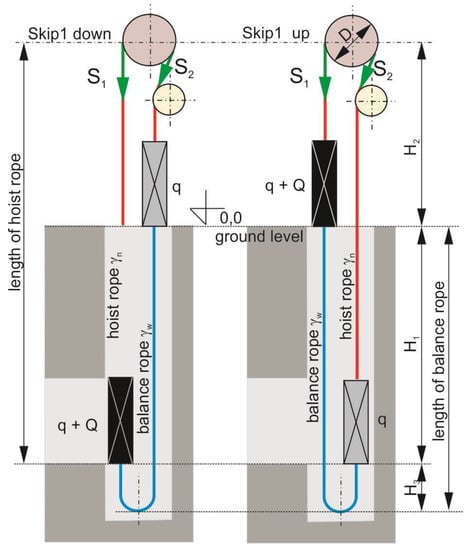
Figure 5.
Scheme of a mining-shaft hoist with a friction drive.
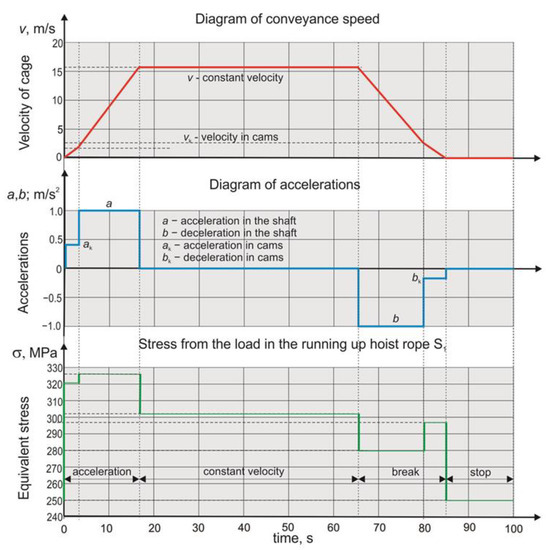
Figure 6.
Diagram of the speed and acceleration of the shaft hoist.
The data for the parameters of the shaft hoist are presented in Table 1. The data of the carrying and balancing ropes necessary for the calculations are given in Table 2. On the basis of these data, the values of the forces in the carrying ropes during operation in one cycle and the average values of the stresses per wire during the phase of running the ropes on the thruster wheel were calculated. The stresses in the rope wires from bending on the thruster wheel were taken into account. This variable was treated as random and described by a normal distribution. The figures shown in the graphs and figures are the values for this example.

Table 1.
Main parameters of hoist and balance ropes.

Table 2.
Technical characteristics of a mining-shaft hoist for calculations of load hoist ropes in one working cycle.
In the next step, the probability distributions of the stress values that can be reached by the individual wires of the rope were compared with random stress distributions determining the breaking strength of the wires coming from sections of the rope with a known weakening. In the calculation example presented here, the results for an eight-strand rope with a metal core of Warrington-Seale design were used. Such ropes are usually used in pulley systems, but could successfully operate in a multi-strand skip hoist, as in this example. In the case of open-cast mining machines, the pulley systems are the key mechanical unit determining the quality and safety of their work. [34]. The reason for adopting such a solution was the knowledge of wire strength distributions taken from sections of these ropes with varying levels of wear [35]. These distributions, with a 95% significance level, are normal. Using these distributions, the probability of an event was calculated in which the average stress in the wires is higher than their strength.
This is shown in Figure 6. For a rope with a weakening of about 20%, this probability is 0.4%. For a rope with a weakening of about 25% (not shown in Figure 7), this probability is 1.65%. This means that the criteria for withdrawing mine-shaft hoist ropes from service relating to a maximum 20% weakening are very demanding in Poland, and ropes reaching these values should be used with more frequent magnetic and visual tests.
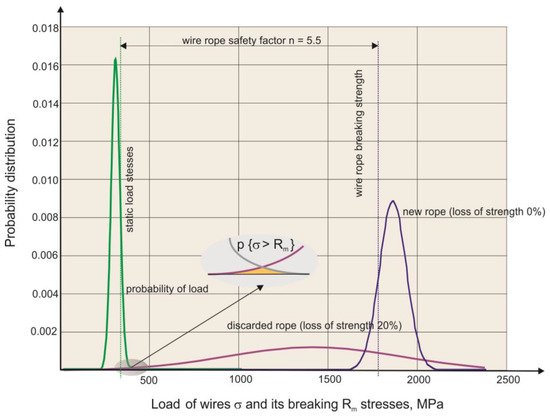
Figure 7.
The probability of an event where the average stress in the wires of the rope is higher than their tensile strength.
4. Application of Non-Parametric Distributions and Their Estimation to Interpret Some Manifestations of Wire Rope Wear
Wire ropes are complex helix structures that are combinations of many different dimensions, wire workmanship, and the use of other materials. Their collective mechanical properties can be identified and compared by analyzing the random distributions of these characteristic variables. As these are mostly multi-modal distributions, advanced statistical methods make it possible to extract the information hidden in the data and attribute it to specific rope structures. This is presented on the basis of the results of wire strength tests of an alignment rope (Figure 8) of a mining-shaft hoist, which broke due to twisting of the core layer of the strands under conditions of excessive corrosion wear of the inner and outer strands.
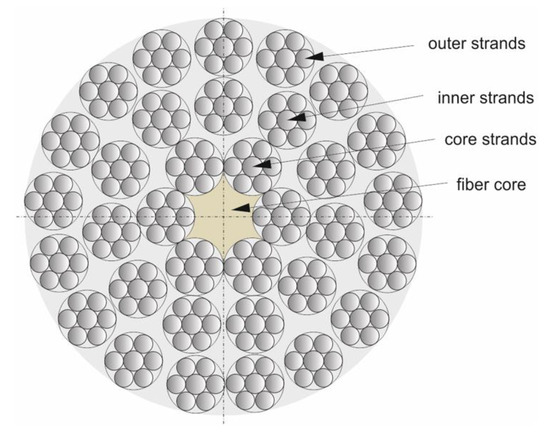
Figure 8.
Cross-section of the rope 34Mx7-FFC.
Figure 9 shows the histogram and estimated normal distribution of the breaking strength of all wires of this multilayer rope. The tests were carried out using the classic method of breaking strength tests. Wire-breaking tests were carried out according to standard requirements, obtaining the breaking strength of individual wires in the strands. Then, based on the obtained forces and known wire cross-sections, individual wires failure stresses were determined, making it possible to create a histogram.

Figure 9.
Histogram and estimated normal distribution of the breaking strength of all wires of the 34Mx7-FC rope where: mi—expected value, and sig—standard deviation.
In Figure 10, the distribution of data in the form of a histogram was approximated and fitted with a unimodal distribution (normal). However, since this distribution is clearly multi-modal, a non-parametric kernel distribution (Epanechnikov method) was fitted to it. This adjustment made it possible to isolate and visualize individual distributions relating to individual elements of the tested rope.
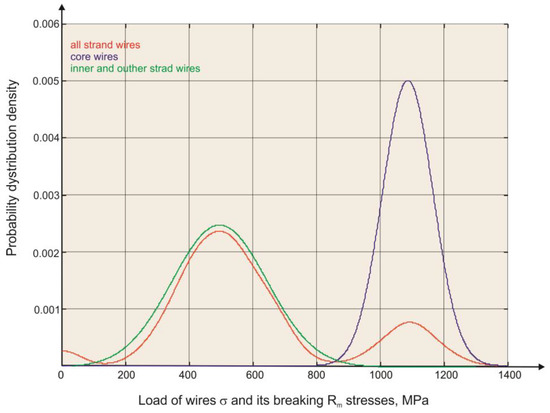
Figure 10.
Non-parametric distribution of the breaking strength of the wires of the 34Mx7−FC rope and normal distributions of the breaking strength of the wires of the individual layers of the rope’s strands.
The test specimen was from a section in the immediate vicinity of the rupture point [36]. This is a bi- or even tri-modal distribution, and the estimated expectation value and standard deviation parameters do not describe the random variations that occur. In order to isolate them, a non-parametric distribution determined using a kernel estimator was used—in this case, with a normal distribution [37]. The determined non-parametric distribution is shown in red in Figure 10. It clearly shows the occurrence of two modes with values around 460 MPa and 1100 MPa, and, less clearly, a third fashion around 0 MPa. This third mode is the result of the identification of several broken wires in the analyzed rope sample. A more precise analysis led to the identification of the causes of this variation in distribution. These are the very large variations in the weakening of the wires of the strands of the inner and outer layers compared to the strands of the core layer. The strands of the outer and inner layers showed very high wear due to corrosion, and even a few wires were broken. The strands of the core layer were virtually without visible signs of weakening due to corrosion. However, as the rope had broken due to the weakening of the core layer wires, the only cause that led to this was the fatigue of its wires caused by the varying torsional moment. This took place under conditions where these layers were tightened by corroded layers of inner strands. As a result, the core strands were twisted.
5. Summary
Complete information from the strength tests of ropes and wires, which, ultimately, affects the assessment of wires and steel ropes, is obtained through statistical analysis of the results. The analysis of the distribution of forces in the tested wires shows that the deterministic evaluation is closely related to the statistical evaluation, proving that the probability of tensile strength can be determined.
The method of stochastic evaluation confirms the validity and usefulness of steel ropes for qualitative evaluation by indicating the probability of damage at specific rope strength parameters.
Defective execution of wires with exceeded tolerance for the set value affects the mean value and standard deviation. Evaluation of the parameters affecting the quality of steel ropes depends on the random distribution of wire rope properties and the tensile strength of the wire, which, in turn, translate into the durability of the steel ropes. Wire parameters are determined in a standard tensile strength test. Tests are performed during the production and evaluation of the product. Determining the acceptable limit value of the standard deviation allows the ropes to be approved for operation. The defectiveness of ropes during production affects the likelihood of damage occurring during the operational process.
The statistical analysis of the strength parameters of the wires shows the relationship between the tensile strength and the diameter of the wire. The relationship between these parameters allows us to determine the proper selection of wire parameters and affects the probability of wire damage in the ropes.
For a safe working time of the ropes until fatigue manifested by wire breakage, it is necessary to know the probability of this damage. For this purpose, the quality of the product can be used by determining the relationship between the probability of damage and the diameter of the tube, and tensile strength. Evaluation of the quality of steel ropes, currently based on wire test results, needs to give an accurate quantitative estimate. None of the methods take into account the rules resulting from the random distribution of results, nor help to discover any anomalies resulting from improper inspection during operation.
6. Conclusions
- Wire ropes are complex helix structures that are a combination of many wires differing in size, strength, and workmanship, which have a random effect on the rate and form of wear;
- The strength tests carried out on sections of rope with different levels of wear indicate that the probability of wire breakage from sections with a weakening of around 20% is high enough to increase the risk of operating ropes with this level of wear, and that this value cannot be exceeded;
- The collective mechanical properties in individual rope elements can be identified and compared by analyzing the empirical random distributions of these characteristic variables;
- As these are mostly multi-modal distributions, advanced statistical methods make it possible to extract the hidden information in the data and attribute it to specific rope structures;
- The method can also be useful for analyzing the wire strength data of new ropes to ascertain their quality, confusion between wires of different workmanship, etc.
Author Contributions
Conceptualization, A.T. and G.O.; methodology A.T., G.O. and M.S.; software, A.T. and G.O.; validation, A.T., G.K. and M.S.; formal analysis, G.K. and M.S.; investigation, A.T., G.K. and G.O.; resources, G.K.; data duration, A.T. and G.K.; writing—original draft preparation, A.T. and G.O.; writing—review and editing, M.S. and G.K.; visualization, A.T. and G.O.; supervision, A.T. All authors have read and agreed to the published version of the manuscript.
Funding
This research received no external funding.
Institutional Review Board Statement
Not applicable.
Informed Consent Statement
Not applicable.
Data Availability Statement
Not applicable.
Conflicts of Interest
The authors declare no conflict of interest.
References
- Olszyna, G.; Gašić, V.; Tytko, A. Some aspects on quantification of the wear at steel wire ropes. Proc. Inst. Mech. Eng. Part J J. Eng. Tribol. 2021, 236, 2032–2041. [Google Scholar] [CrossRef]
- Olszyna, G.; Tytko, A.; Sioma, A. Assessment of the condition of hoisting ropes by measuring their geometric parameters in a three-dimensional image of their surface. Arch. Min. Sci. 2013, 58, 643–654. [Google Scholar] [CrossRef]
- Gasić, V.; Olszyna, G. Steel Ropes in Machines Opencast: New trends in Production Engineering: Monograph; Part. 1, Engineering and technology; Kotwica, K., Ed.; Sciendo: Warszawa, Poland, 2019; pp. 312–320. [Google Scholar]
- Hansel, J. Podstawy Teoretyczne Prognozowania Czasu Pracy Lin Stalowych; Zeszyt Naukowy AGH nr 84; AGH: Kraków, Poland, 1977. [Google Scholar]
- Szymszal, J.; Gajdzik, B. Steel industry 4.0 in the perspective of forecasted quantities of steel production in the world. Arch. Foundry Eng. 2017, 17, 224–230. [Google Scholar] [CrossRef]
- Radzikowska, B. Metody Prognozowania. Zbiór Zadań; Akademia Ekonomiczna: Wrocław, Poland, 2001. [Google Scholar]
- Bas, E.; Egrioglu, E.; Yolcu, U. Bootstrapped Holt Method with Autoregressive Coefficients Based on Harmony Search Algorithm. Forecasting 2021, 3, 839–849. [Google Scholar] [CrossRef]
- Holt, C.C. Forecasting seasonals and trends by exponentially weighted moving averages. Int. J. Forecast. 2004, 20, 5–10. [Google Scholar] [CrossRef]
- Rahmawati, A.; Ramadhanti, C.N.; Ismia, F.H.; Nurcahyo, R. Comparing The Accuracy of Holt’s and Brown’s Double Exponential Smoothing Method in Forecasting The Coal Demand of Company X. In Proceedings of the International Conference on Industrial Engineering and Operations Management, Bangalore, India, 16–18 August 2021. [Google Scholar]
- Kubiś, B.; Olszyna, G.; Szade, P.; Tytko, A. Fatigue Life of Compacted Wire Ropes for Applications in Deep Mining. Manag. Syst. Prod. Eng. 2023, 31, 95–101. [Google Scholar] [CrossRef]
- Zyl, V.M. Deterioration Mechanism of Drum Winder Ropes; GAP 501; Mike von Zyl Incrporated: Pretoria, South Africa, 2000. [Google Scholar]
- Białowąs ECholewa, W.; Oleksy, W. Quality criteria of wire ropes. Mechanika 1985, 4, 79–84. [Google Scholar]
- Olszyna, G.; Tytko, A. Badania lin pracujących w maszynach podstawowych górnictwa odkrywkowego. In Nauka-Technika-Technologia; Wydawnictwa AGH: Kraków, Poland, 2022; Volume 3, pp. 55–67. [Google Scholar]
- Tytko, A. Modelowanie Zużycia Zmęczeniowego I Diagnostyka Lin Stalowych; Rozprawy Monografie, nr 65; Wydawnictwa AGH: Kraków, Poland, 1998. [Google Scholar]
- Lafitte, M.H.; Bunsell, A.R. The fatigue behaviour of Kevlar-29 fibres. J. Mater. Sci. 1982, 17, 2391–2397. [Google Scholar] [CrossRef]
- Chevillotte, Y.; Marco, Y.; Bles, G.; Devos, K.; Keryer, M.; Arhant, M.; Davies, P. Fatigue of improved polyamide mooring ropes for floating wind turbines. Ocean Eng. 2020, 199, 107011. [Google Scholar] [CrossRef]
- Frick, W. Loss of breaking load of high-strength wires during transverse pressure. In Proceedings of the OIPEEC Conference—Exploring Opportunities—Synthetic/Steel, Den Haag, The Netherlands, 12–15 March 2019; Dohm, M.A.R., Ed.; OIPEEC: Meylan, France, 2019; pp. 247–265. [Google Scholar]
- Hankus, J. Budowa i Własności Mechaniczne Lin Stalowych; Główny Instytut Górnictwa: Katowice, Poland, 2000. [Google Scholar]
- Warszyński, M. Niezawodność w Obliczeniach Konstrukcyjnych; PWN: Warszawa, Poland, 1989. [Google Scholar]
- Kamal, M.; Rahman, M.; Sani, M. Application of Multibody Simulation for Fatigue Life Estimation. Int. J. Automot. Mech. Eng. 2013, 7, 912–923. [Google Scholar] [CrossRef]
- Kamal, M.; Rahman, M.M. Fatigue life estimation models: A state of the art. Int. J. Automot. Mech. Eng. 2014, 9, 1599–1608. [Google Scholar] [CrossRef]
- Kamal, M.; Rahman, M. Finite Element-Based Fatigue Behaviour of Springs in Automobile Suspension. Int. J. Automot. Mech. Eng. 2014, 10, 1910–1919. [Google Scholar] [CrossRef]
- Winkler, J.; Georgakis, C.T.; Fischer, G. Fretting fatigue behavior of high-strength steel monostrands under bending load. Int. J. Fatigue 2014, 70, 13–23. [Google Scholar] [CrossRef]
- Mahmud, M.; Abdullah, S.; Yunoh, M.; Ariffin, A.; Nopiah, Z. Damaging fatigue cycles determination for random service loadings using mixed Weibull analysis. Int. J. Automot. Mech. Eng. 2016, 13, 3628–3641. [Google Scholar] [CrossRef]
- Mohamed, S.; Abdullah, S.; Arifin, A.; Ariffin, A.; Padzi, M. Characterization of the biaxial fatigue behaviour on medium carbon steel using the strain-life approach. Int. J. Automot. Mech. Eng. 2016, 13, 3262–3277. [Google Scholar] [CrossRef]
- Salleh, S.; Abdullah, M.; Abdulhamid, M.; Tamin, M. Methodology for reliability assessment of steel wire ropes under fretting fatigue conditions. J. Mech. Eng. Sci. 2017, 14, 2488–2502. [Google Scholar] [CrossRef]
- Pamula, W. Niezawodność I Bezpieczeństwo; Wydawnictwo Politechniki Śląskiej: Katowice, Poland, 2011. [Google Scholar]
- Mi, J.; Li, Y.-F.; Peng, W.; Huang, H.-Z. Reliability analysis of complex multi-state system with common cause failure based on evidential networks. Reliab. Eng. Syst. Saf. 2018, 174, 71–81. [Google Scholar] [CrossRef]
- Li, Y.-F.; Liu, Y.; Huang, T.; Huang, H.-Z.; Mi, J. Reliability assessment for systems suffering common cause failure based on Bayesian networks and proportional hazards model. Qual. Reliab. Eng. Int. 2020, 36, 2509–2520. [Google Scholar] [CrossRef]
- Huang, T.; Xiahou, T.; Li, Y.-F.; Qian, H.-M.; Liu, Y.; Huang, H.-Z. Reliability assessment of wind turbine generators by fuzzy universal generating function. Eksploat. i Niezawodn.-Maint. Reliab. 2021, 23, 308–314. [Google Scholar] [CrossRef]
- Li, Y.-F.; Huang, H.-Z.; Mi, J.; Peng, W.; Han, X. Reliability analysis of multi-state systems with common cause failures based on Bayesian network and fuzzy probability. Ann. Oper. Res. 2019, 311, 195–209. [Google Scholar] [CrossRef]
- Mouradi, H.; El Barkany, A.; El Biyaali, A. Steel wire ropes failure analysis: Experimental study. Eng. Fail. Anal. 2018, 91, 234–242. [Google Scholar] [CrossRef]
- Szklarski, L.; Zarudzki, J. Elektryczne Maszyny Wyciągowe; Wydawnictwo PWN: Warszawa, Poland, 1998. [Google Scholar]
- Olszyna, G.; Tytko, A. A tool for determining the number of bends and places of accumulation of potential wear of steel ropes operating in the luffing systems of basic opencast mining machines. Min. Mach. 2022, 40, 229–237. [Google Scholar] [CrossRef]
- Tytko, A. Strength testing of retired main hoist ropes of multi-bucket wheel excavators. In Proceedings of the OIPEEC Conference, College Station, TX, USA, 22–24 March 2011. [Google Scholar]
- Tobys, J.; Morawski, K. Badania po Odłożeniu Odcinków Liny Wyrównawczej o Średnicy 46 mm Typu „34M” Firmy BRIDON-BEKAERT Konstrukcji: 34M(17/11/6/FFC); Unpublished Work in PDF Format; ZRUT AUTORYTET: Polkowice, Poland, 2022. [Google Scholar]
- MATLAB. The Language of Technical Computing, Version 2022Rb; Mathsoft Inc.: Lafayette, LA, USA, 2022.
Disclaimer/Publisher’s Note: The statements, opinions and data contained in all publications are solely those of the individual author(s) and contributor(s) and not of MDPI and/or the editor(s). MDPI and/or the editor(s) disclaim responsibility for any injury to people or property resulting from any ideas, methods, instructions or products referred to in the content. |
© 2023 by the authors. Licensee MDPI, Basel, Switzerland. This article is an open access article distributed under the terms and conditions of the Creative Commons Attribution (CC BY) license (https://creativecommons.org/licenses/by/4.0/).